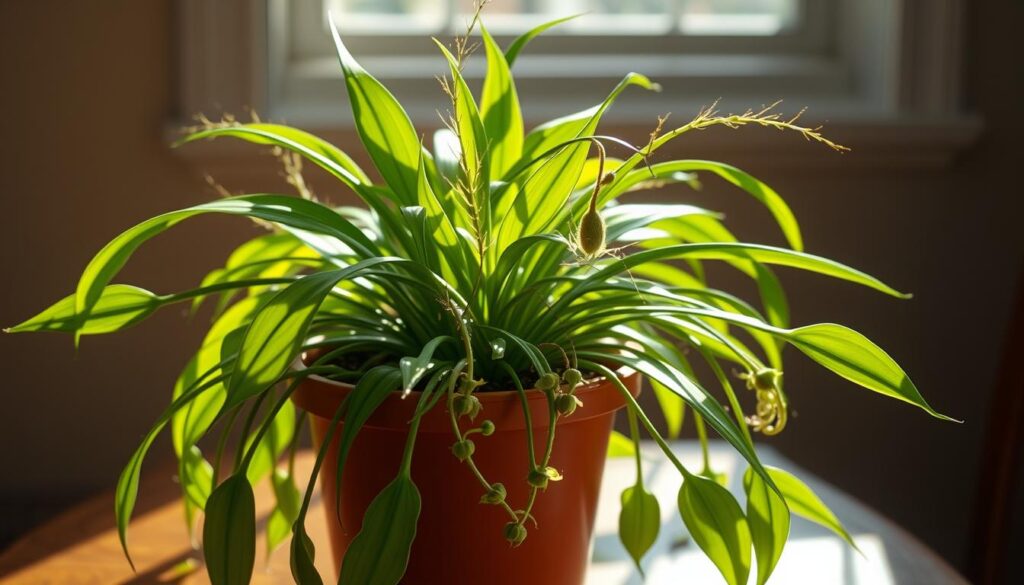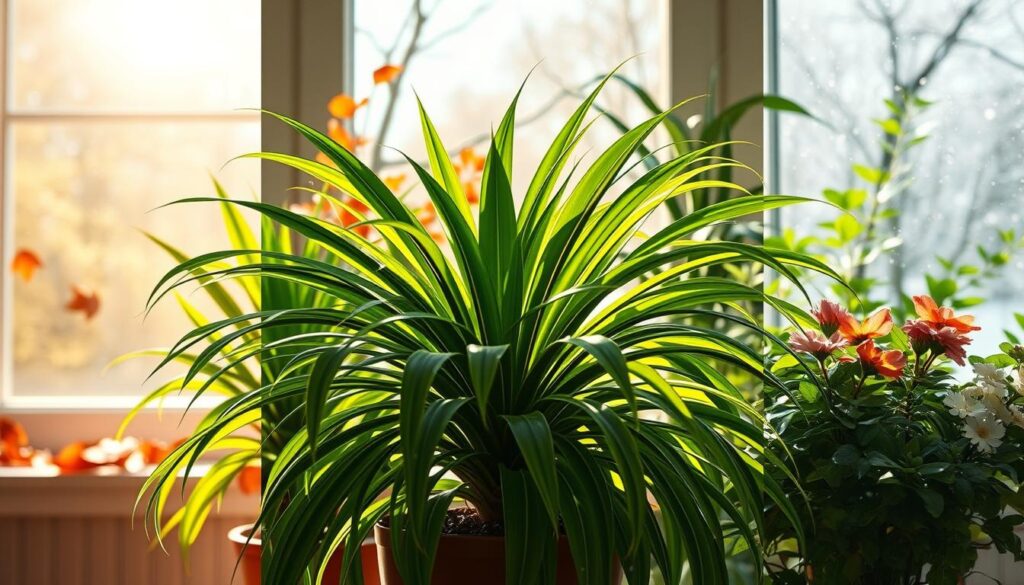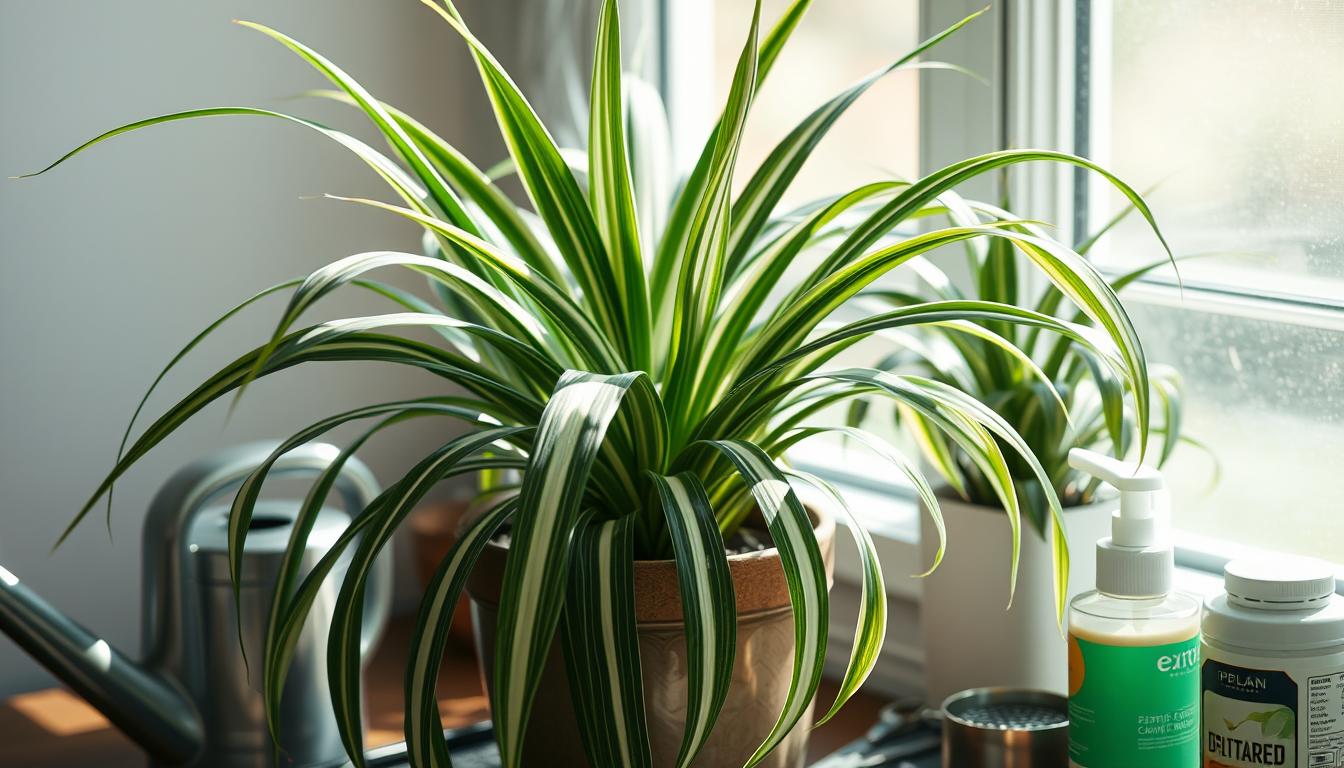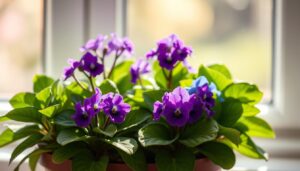Spider Plants are safe for pets like cats and dogs. They are non-toxic. This makes them perfect for homes with pets. You can find out more about Spider Plant care and how to keep them happy.
Spider Plants like temperatures between 60°F and 80°F. They need 4 to 6 hours of bright, indirect light each day. They also help make the air in your home more humid. This can help if you have breathing problems.
To care for Spider Plants, water them about once a week. Check the soil moisture first. By following these tips, you can enjoy their air-purifying benefits and their beautiful leaves.
Understanding the Spider Plant’s Unique Characteristics
Spider Plants are loved for their special traits. They come in many varieties, so you can pick the one you like best. Some have cool leaves, while others have curly stems or grow in a neat way.
Knowing about Spider Plants helps you take good care of them. They clean the air by removing bad stuff like formaldehyde and benzene. Plus, they’re easy to grow and great for new plant owners.
Some popular Spider Plant varieties include:
- Chlorophytum comosum ‘Variegatum’ – striped leaves (green on outside, white on inside)
- Chlorophytum comosum ‘Reverse Variegatum’ – white on outside, green on inside
- Chlorophytum comosum ‘Bonnie’ – curly variegated foliage
By picking the right Spider Plant and caring for it well, you get to enjoy its benefits. These include cleaning the air and looking really cool.
| Spider Plant Variety | Description |
|---|---|
| Chlorophytum comosum ‘Variegatum’ | Striped leaves (green on outside, white on inside) |
| Chlorophytum comosum ‘Reverse Variegatum’ | White on outside, green on inside |
| Chlorophytum comosum ‘Bonnie’ | Curly variegated foliage |
Ideal Growing Conditions for Spider Plants
To keep your Spider Plant happy, it needs the right growing conditions. They love bright, indirect light. This is perfect for rooms with east- or west-facing windows. Direct sunlight can burn their leaves, so indirect light is best.
Spider Plants do well in temperatures between 60-75°F (15-24°C). This is the same as average home temperatures. They also like a low humidity environment.
Optimal Light Requirements
Spider plants grow well in both bright and low light. But, too much bright light can burn their leaves. So, it’s best to keep them in indirect light.
Best Temperature Range
Spider plants like room temperatures between 55 and 80°F (13–27°C). This range helps them grow and thrive indoors.
Humidity Levels for Flourishing Growth
Spider plants prefer low humidity. This makes them great for rooms with average humidity. Keep the humidity low to prevent root rot and other problems.
By giving your Spider Plant the right conditions, it will thrive. This includes the right light and temperature. You’ll enjoy its beautiful, lush foliage.
| Lighting Conditions | Temperature Range | Humidity Levels |
|---|---|---|
| Bright, indirect light | 60-75°F (15-24°C) | Relatively low humidity |
| Low light | 55-80°F (13-27°C) | Average humidity levels |
Watering Your Spider Plant Effectively
It’s key to water your Spider Plant right. A guide will show you how much water it needs. Too much water can hurt the roots, while too little can dry out the leaves.
Water your Spider Plant about once a week. Stick your finger into the soil up to the first knuckle. If it’s dry, it’s time to water. The top two inches of soil should be dry before you water.
Signs of Overwatering
- Yellowing leaves
- Droopy stems
- Soft, mushy texture
Signs of Underwatering
- Crispy and dry leaves
- Brown tips on leaves
Follow these tips to water your Spider Plant well. Let the soil dry a bit between waterings. This stops problems like fungus and yellow leaves.
With good watering, your Spider Plant will grow strong. Remember to feed it once or twice a month. Also, repot it every other year to keep it healthy.
| Watering Frequency | Soil Moisture | Signs of Overwatering | Signs of Underwatering |
|---|---|---|---|
| Once a week | Dry to the touch | Yellowing leaves, droopy stems | Crispy and dry leaves, brown tips |
Choosing the Right Pot and Soil
Choosing the right soil for Spider Plants is key. You need a mix that drains well to avoid waterlogged soil and root rot. For more tips on picking the right mix, check out trusted houseplant guides. A good mix should have organic materials and fertilizers for healthy growth.
Here are some things to think about when picking a potting mix:
- Drainage: A mix that drains well is important to avoid waterlogged soil and root rot.
- Aeration: The mix should let air in to keep roots healthy.
- Nutrient content: A mix with balanced fertilizers helps plants grow well.
Choosing the right pot and soil is crucial for your Spider Plant’s health. Pick a pot that’s a bit bigger than the plant’s roots.
https://www.youtube.com/watch?v=gHMQuiW7-Hk
Recommended Potting Mix for Spider Plants
A good mix for Spider Plants is light and slightly acidic, with a pH of 5.5 to 6.5. You can make your own mix with peat moss, perlite, and vermiculite. It’s essential to note that the best mix holds moisture but drains excess water well.
Fertilizing Your Spider Plant for Best Results
To keep your Spider Plant happy, you need a fertilizing plan. Use a balanced, water-soluble fertilizer during the growing season. This is spring and summer. How often you fertilize depends on the fertilizer and your plant’s growth.
For a simple plan, use a 20-20-20 fertilizer once or twice a month. Always follow the maker’s instructions to avoid too much fertilizer. Too much can harm your plant.
- Choose a balanced fertilizer with equal nutrients (nitrogen, phosphorus, and potassium)
- Don’t over-fertilize to avoid brown tips and slow growth
- Stop fertilizing in fall and winter to let your plant rest
By following these tips, you can help your Spider Plant grow well. This will keep it healthy and strong.
| Fertilizer Type | Application Frequency | Season |
|---|---|---|
| 20-20-20 | Once or twice a month | Spring and summer |
| Organic fertilizer | Once a month | Spring and summer |
Propagating Your Spider Plant
As you care for your Spider Plant, you might see baby plants. These are called spiderettes. You can use Spider Plant propagation to share them with friends.
To start, take the spiderettes off the mother plant. You can root them in water or soil. Soil works better because roots grow stronger.
Here are some tips for successful Spider Plant propagation:
- Remove spiderettes with at least 2 inches of stem and a few leaves
- Root the spiderettes in water or soil, changing the water every few days
- Keep the soil moist but not soggy, and provide bright indirect light
By following these tips, you can grow new Spider Plants. Watch for leaf color changes. This means your plant might need more water or be too wet.

With the right care, your new Spider Plants will do great. You’ll enjoy the fruits of your Spider Plant propagation.
| Propagation Method | Success Rate | Time to Root |
|---|---|---|
| Soil Propagation | Higher | 7-10 days |
| Water Propagation | Lower | 7-10 days |
Common Pests and Diseases to Watch For
When you take care of your Spider Plant, watch out for pests and diseases. Spider Plant common problems include pests like spider mites, mealybugs, and scale. Use insecticidal soap or neem oil to treat them. Catching them early is key to stop disease.
Keep an eye on your plant to spot problems early. Look for white, cotton-like fluffs or fine webbing. Yellow sticky traps can catch flying pests like fungus gnats and whiteflies.
Identifying Common Pests
- Aphids: often found clustered on new growth, leaving behind honeydew that attracts ants
- Mealybugs: appear as white, cotton-like fluffs on the leaves, can kill plants if untreated
- Spider mites: thrive in dry climates, early signs include yellow spots on leaves, can quickly escalate to brown leaves and plant death
Prevention and Treatment Methods
To stop Spider Plant problems, keep your space clean and well-ventilated. Don’t overwater, as it attracts pests like fungus gnats. Treat infestations with insecticidal soap or neem oil. Introduce beneficial insects like ladybugs or lacewings to control pests.
Seasonal Spider Plant Care Tips
As you care for your Spider Plant, remember the seasons change. Spider Plant care changes with the seasons. In winter, your plant needs less water and food because it’s sleeping.
This sleep is part of its life. Less water and food help avoid root rot and other issues.
In summer, your plant needs more water and food to grow well. Keep the temperature above 50°F to protect it. Changing your care with the seasons helps your plant grow and stay happy.

- Reduce watering in autumn and winter, as the plant requires less moisture during this time.
- Increase watering in spring and summer, as the plant is actively growing and requires more moisture.
- Fertilize your Spider Plant once a month during the growing season (spring and summer) to promote healthy growth.
Follow these tips for seasonal care. Your plant will bloom with beautiful white flowers and baby plantlets. Always watch your plant and change care as needed for the best results.
Enhancing Aesthetic Appeal with Spider Plants
Exploring Spider Plant display ideas opens up many creative ways to show off these plants at home. Their trailing stems and leaves bring elegance to any room. They’re great for decorating ideas. Mixing them with other plants creates a stunning display that makes your space look better.
Popular ways to display Spider Plants include hanging baskets, terrariums, and decorative pots. You can also try different setups, like grouping plants or using one as a centerpiece. The most important thing is to have fun and show your style.
Spider Plant decorating ideas are endless. They can brighten a room, create a calm atmosphere, or make a bold statement. Adding Spider Plants to your decor makes your home more welcoming and beautiful.
Here are some more ideas for Spider Plant displays:
- Use a macrame hanger to hang a Spider Plant from the ceiling.
- Make a living wall with Spider Plants and other plants.
- Place a Spider Plant on a decorative shelf or mantle.
Trying out these ideas and others can help you find the best way to show off your plants. This will make your home look even more beautiful.
Troubleshooting Common Spider Plant Issues
Spider plants are tough, but they can still face problems. Yellow leaves might mean too much water, not enough water, or missing nutrients. Stunted growth often comes from too little light or not enough food.
By watching your plant closely and fixing problems fast, it can stay healthy and green. This way, your spider plant will keep looking good and growing well.
With the right care, your spider plant can be a great, easy-to-care-for addition to your home. Make sure it has the best growing conditions. Watch out for pests and diseases. And fix any issues quickly. This will help you enjoy your spider plant’s beauty and benefits for many years.
If you would like to see more about the 25 most trending houseplants of which the spiderplant is one check us out here for more on the most trending houseplants guide.



